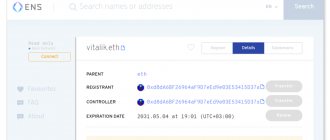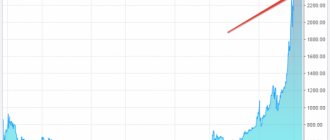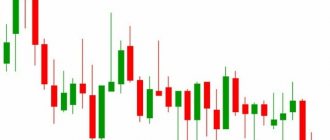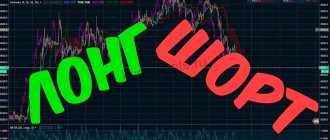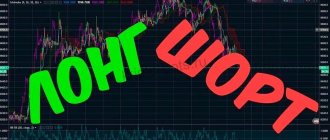- The simplest example of carry trade
- Rollover in the foreign exchange market
- Kerry trade: an example from life
- Profitable carry trade
- Unprofitable carry trade
- Low and high levels of risk aversion
- How to choose a currency pair for a carry trade
- Examples
- Risks in carry trade
- Let's sum it up
From time to time the mysterious “carry trade” is written about in economic news in this vein: they say, the ruble has fallen? Once again these nasty carry traders have ruined all our raspberries. No, to describe it in simple terms, is it really that difficult?
Not difficult. Indeed, carry trade operations have a powerful impact on the foreign exchange market of many countries.
What kind of carry is this? This is the curry sauce of borrowing or selling a financial instrument with a low interest rate and then using it to buy an instrument with a high interest rate.
By paying low interest on an instrument sold or borrowed, you, at the same time, collect high interest on the instrument purchased. It is clear that your profit will be the difference in percentage.
The essence of the carry trade
Carry trade is a strategy based on the purchase of assets with low interest rates and subsequent conversion into high-yield market instruments. The trader's income is the difference in interest rates.
For clarity, let's give an example: I take out a loan in dollars at 2% per annum and invest the money in stocks with a yield of 9% per annum. In this case, the income should be 7%. However, not all so simple. The fact is that I will receive that same 7% only when buying shares of American companies. And if I want to purchase securities on the Russian market or the currency of another country, then the income will decrease by the amount of conversion costs and broker commissions.
You can hedge against the risk of exchange rates by purchasing USD/RUB futures secured by ruble OFZs with a yield of 8%. Hedging costs will be around 5%. Then the investor's profit will be:
8-2-5=1 %.
If you decide to make money on carry trade, you should know that this implies the following conditions:
- it is preferable to trade assets from different countries;
- this strategy is suitable mainly for large investments;
- it is necessary to take into account risks beyond the control of the trader.
Next, we will examine in more detail why it is very desirable to fulfill these conditions.
Who is this strategy suitable for?
Definitely not for passive investors. I don’t believe in stable profitable trading in currencies. Perhaps the strategy will appeal to those who have large capital in a stable currency, or have the opportunity to attract it at a very low interest rate.
In conclusion, I would like to advise traders to work with carries very carefully. Despite its apparent simplicity, an unsuccessful entry can deprive you of not only income, but also part (if not all) of your capital. Therefore, before using this strategy, calculate everything, weigh all the pros and cons. If it turns out to be 50x50, don't start. This is a recipe for failure.
And I say goodbye to you until the next article. If you liked the content, subscribe now to stay up to date with all the news.
Features of the carry trade strategy
The most important instrument of monetary policy of any state is the key rate. In Russia, for example, the rate is set by the Central Bank several times a year, and its value is tied to the inflation rate. When the rate of inflation slows, the rate decreases and, conversely, when the rate is high, it increases. Thus, at the end of 2013 its size was 5.5%, and at the beginning of 2015 – 17%. This is due to the depreciation of the ruble at the end of 2014, caused by the introduction of political sanctions and a decrease in world oil prices.
Carrie Forex trading
If we look at the history of the carry trade, we find out that this strategy has been used since the 80s of the last century. To buy and sell currencies on Forex, you will need a deposit and an information and trading terminal. In simple terms, a carry trade on Forex is the purchase of the currency of a country where there are low interest rates for subsequent conversion into a currency with high rates. At the same time, there is no need to sit at the terminal around the clock and monitor changes in exchange rates and interest rates.
How to choose a currency pair for a carry trade
On the Internet you can find various ratings of currency pairs for carry trades, but this data quickly becomes outdated. Therefore, it is recommended to independently check the relevance of interest rates. To choose the best pair, you need to follow these steps:
- find the largest difference in interest rates;
- We study data on the selected pair: we look at graphs, analytical data and forecasts;
- determine the trend.
A trend in Forex is the direction of price movement. There are upward and downward trends. In an uptrend, the price of an asset consistently moves upward, impulses (price increases) prevail over pullbacks. In a downward trend, on the contrary, the price moves down: two or more price peaks can be found on the chart, with each subsequent one located below the previous one.
In the pair we have chosen, the rate of the purchased currency should be in an upward trend, and the rate of the loan currency should be in a downward or flat trend (when the price is within a certain range for a long time).
If these conditions do not meet for the selected currency pair, you should select another pair.
How does the strategy work?
Usually, the details of carry trade contain the theory of formation of discount rates, problems of clearing international export/import transactions and other certainly useful information for the general development of the trader, but as a result we get “you can’t see the forest for the trees.” Those who want to thoroughly understand the theory can easily do this via the Internet, but in reality everything is much simpler and is based on one basic element - a currency swap.
So, swap is a commission charged for transferring an open transaction to the next trading day. In fact, two operations occur with the position: closing at 00:00 UMT with the simultaneous opening of a new one. This is what a swap looks like from a trader’s point of view; current values can be found in the MetaTrader trading terminal.
Swap values for Carry Trade in the MetaTrader terminal.
Click the button to go through the step-by-step guide to “Carry Trade” and master the strategy in a few simple steps Explore »
Current data shows that the swap is positive for long (Buy) positions and negative for short (Sell) positions. From the broker’s point of view, it represents the difference in discount rates for purchase and sale transactions of a currency pair and is calculated as follows:
- If before 21:00 UMT the discount rate for a currency pair calculated by the World Bank is less after 21:00 UMT, then the swap is positive and is credited to the trader’s deposit.
- Accordingly, if before 21:00 UMT the rate was higher, we get a negative swap, which is written off in favor of the dealing center.
- Additionally, the broker adds his own commission.
Thus, medium- and long-term traders can receive both additional income and cumulative losses from the carry trade. If a position is open on major currency pairs and lasts no more than 1-2 weeks, then swaps do not have a significant impact on the final result. If longer, then in an unfavorable situation they can take a significant part of the profit. Traders who practice locking positions or use “grid” trading strategies should also remember this.
In general terms, obtaining passive profit using the carry trade method looks like this:
- We open positions only in the direction of positive swaps, and they should remain so for at least 2-3 months on average.
- We receive commissions from the broker at the beginning of the day. In the example above, this is 1.25% of the NZD/NZD buy trade.
- If the market situation remains stable, we continue to keep positions open.
Click the button to go through the step-by-step guide to “Carry Trade” and master the strategy in a few simple steps Explore »
Beginners may think that 1.25% is not money to pay attention to, but if everything goes well, the carry trade gives 12-15% profit monthly, which is not always the case even with a scalping strategy. Moreover, this is a stable income in such difficult periods as low volatility or sideways movement (flat), where even professionals find it difficult to make money.
As a result, the calculation algorithm has the following form:
Formula for calculating the result of a carry trade.
Advantages:
- Double income. If positions become profitable along the trend line, then in addition to several positive swaps, Forex trading itself also brings additional income.
- Minimal control of open transactions. Unlike intraday trading, in carry trade there is no need to constantly monitor the status of positions - it is enough to monitor current trends 1-2 times a day.
Click the button to go through the step-by-step guide to “Carry Trade” and master the strategy in a few simple steps Explore »
Carry Trade on the stock market
You can make money on the difference in rates not only with the help of currencies. In the stock market, the carry trade strategy is often used in relation to government bonds (bonds).
It is known that bonds have low returns, but they are a more reliable instrument than shares and bonds of companies due to minimal risk. The yield of such securities is tied to the key rate of the Central Bank.
What is a carry trade in the stock market? This is the attraction of borrowed funds in the currency of the state, where there is a low interest rate on loans for subsequent investment in government bonds with high yield. In some countries, bonds are a highly profitable instrument, which allows them to attract funds from foreign investors.
How much can you earn
Nothing can be known for sure here. Still, this is not a bank deposit in native currency at a fixed interest rate. In order to estimate your expected income, you need to consider the following factors:
- Difference in rates of funding and investment currencies.
- The prevailing trend of currency movements.
- Selecting suitable assets in the investment currency and the level of income on them.
Typically, the investor's net income from this strategy does not exceed 5-8% per annum.
Advantages and risks of carry trade
The main advantage of the strategy is its long-term nature with minimal time investment. In addition, it is possible to receive double profits:
- positive swap commission;
- income upon closing the transaction.
A swap is the purchase of an asset for subsequent sale after a specified period of time.
The disadvantages of the carry trade are as follows:
- Relatively small profit for the year.
- The need to have a large deposit.
- The risk of possible trend changes due to political or economic turmoil.
For example, the carry trade index for Russia depends on the price of oil. Falling oil prices weaken the ruble, and along with this, demand for Russian government bonds also falls. If a strong correction occurs, investors close positions in the Russian currency and transfer funds to protective assets - the dollar, Swiss franc or Japanese yen.
Rollovers and swaps
In the foreign exchange market, settlement occurs two days after the transaction is registered. In this case, brokers use position transfer (rollover). This means that positions are automatically carried forward to the next settlement date. Thus, physical delivery of the currency is never made.
Most brokers typically use the New York close of 5:00 pm ET as their settlement time, but this may vary from broker to broker. Particular attention is paid to transactions between Wednesdays and Thursdays. Since settlement does not occur on the weekend, these trades settle on Monday with an additional two days of interest accrual.
A swap agreement, also called a swap, is a type of currency agreement between counterparties. Typically, the dealing bank uses the overnight Libor rate plus a specified spread to calculate interest. Depending on the arrangement your broker has, they will then add their own fees to it to arrive at the final cost of the swap.
An example of using the carry trade strategy
- Carrie trader deposits CHF 500,000 with a broker. Switzerland currently has a negative interest rate of -0.75% with a minus sign.
- Next, a deal is opened to purchase $520,000. For this currency the interest rate is 0.25%.
- We determine the difference in rates: 0.25-(-0.75)=1%.
- We calculate the swap size per day. To do this, divide the difference in rates by the number of days in a year: 1/365=0.00274. We multiply this number by the number of purchased monetary units: 0.00274*520000=106,800 rubles. ($1,424 or 41,296 UAH).
- We determine the value of the USD/CHF pip using an auto calculator. We get the value 0.1.
- We calculate annual profit. To do this, multiply the cost of the point by the size of the swap and the number of days: 0.1*1424.80*365=3,900,375 rubles. ($52,005 or 1,508,145 UAH).
How to calculate interest income
As we have already discussed, one of the main advantages of positive carry trading is the ability to earn passive interest income. This income is earned for each day we engage in a positive carry trade, or paid by us for each day we engage in a negative carry trade. And since most traders use leverage in their trading, the carryover percentage may increase.
Let's look at the math to understand how to calculate interest income for rolling over positions.
Daily interest credit/debit = notional contract value * (base currency interest rate - currency quote interest rate) / 365 days a year * current base currency rate
So let's plug some numbers into this equation using a hypothetical currency trading example for EUR/USD:
We have a long position (1 lot) on EUR/USD, and EUR/USD is trading at 1.2000. The short-term interest rate in Euros is 4% and the short-term interest rate in US dollars is 2%.
100,000 * (0.04 - 0.02) = 2,000 / 365 x 1.20 = 438
2000/438 = 4,57 $
Therefore, our daily premium credit on a long position would be $4.57. On the other hand, if you are short the EURUSD pair, you will have to pay this amount every day.
However, keep in mind that the amount will vary slightly as banks use an overnight interest rate that will fluctuate daily. Based on this example, we want to calculate what our annual return will be if the interest rate paid remains the same:
If we take $4.57 and multiply by 365, we get $1,668.
Assuming you are trading with 1:10 leverage, this position will earn you 1668 on $10,000, resulting in a return of 16.68%. Keep in mind, you are not paid interest on the notional value, but on the $10,000 amount. There are forex trading calculators that will make this calculation easier for you.

